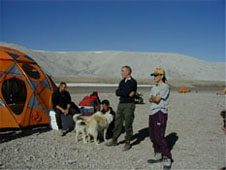|

|
With Oz, Samson, Nicolas, and Loretta,
it was like a graduate school summer camp
|
|
All in good spirits on Saturday. 168
hours of continuous sunshine. Eskimo smiles.
|

|
|

|
"Clear liquids only"
|
|
Participant Observation
|

|
|

|
"You see perched terraces"
"Yes, channeled
scablands... ice margin drainages."
|
|
The butte by the proposed von Braun
Planitia landing strip is "The Fortress."
|

|
|

|
A nearby drainage canyon has been named
for Pete Conrad, who died last week.
|
|
Pascal responded, "These holes actually
have names, so we should stick to auger hole 1, auger hole 2..."
|

|
|

|
The best way to observe
life here is by sitting in the dome tent, reading.
|
|
1/1000 meteorites are from
Mars.
Nobody is real clear on how it can happen at all.
|

|
|

|
7:30AM with long broken
clouds and brilliant flashes on the breccia: "Here comes the sun"
|
|
After two weeks, I find myself pushing
rocks aside on the dirt floor.
|

|
|

|
Walking on untrod land beyond the
crater, a most mysterious space by the falls, I'm reminded of
Castenada. An attenuated reality. As if this infinity of
gray, polished stones could speak.
|
|
Now that the river has abated and the
last spots of snow nearly dried, only the sky changes. Huge cloud
banks extend over the valley, giving way to pristine blue skies.
Then in an hour, balmy breezes shift to a numbing sharp wind.
|

|
|

|
This stony land remains
empty, like a farmerís late winter field.
|
|
The sun glares
continuously, with nary a darkening to hasten sleep.
|

|
|

|
As if fifteen people were camping alone
in San Francisco Bay and nobody closer than Nevada.
|
|
Looking south down
Haughton's terraced valley:
More and more of nothing.
|

|
|

|
Speaking biogeo-logic: "We performed a
dual-channel ethnographic video observation of bidisciplinary
collaborative scientific fieldwork in the High Arctic."
|
